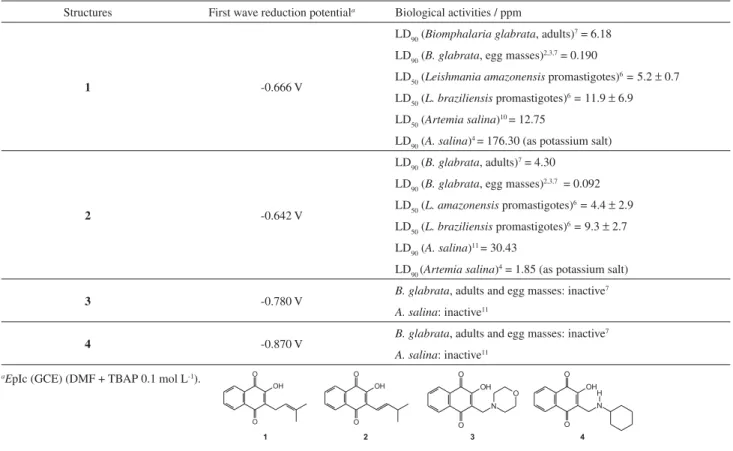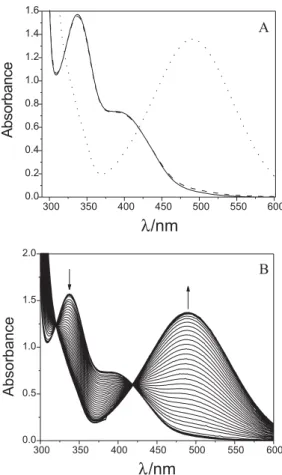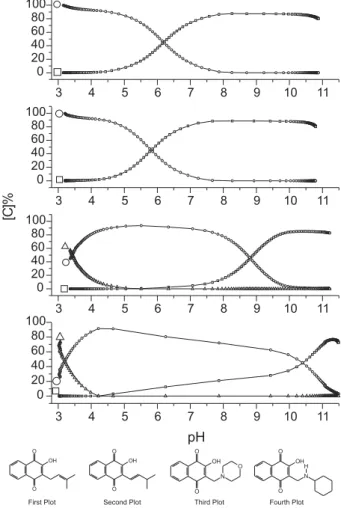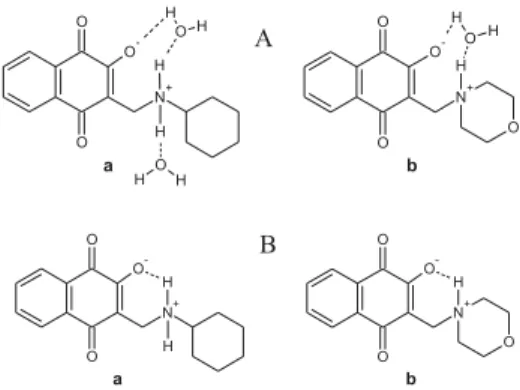Article
0103 - 5053 $6.00+0.00*e-mail: mofg@ufal.br; marilia.goulart@pq.cnpq.br
Determination of the pK
aValues of some Biologically Active and Inactive Hydroxyquinones
Tadeusz Ossowski,
aMarília O. F. Goulart,*
,bFabiane C. de Abreu,
bAntônio Euzébio G. Sant’Ana,
bPaulo
Rogério B. Miranda,
bCicero de Oliveira Costa,
bAdam Liwo,
aPiotr Falkowski
aand Dorota Zarzeczanska
aaFaculty of Chemistry, University of Gdansk, Sobieskiego 18, 80-952, Poland
bInstituto de Química e Biotecnologia, Universidade Federal de Alagoas, Tabuleiro do Martins,
57072-970 Maceió-AL, Brazil
As constantes de dissociação aparentes (pKa) de quatro 2-hidroxinaftoquinonas, diferente-mente substituídas em C-3, foram determinadas em meio aquoso-etanólico (1:1, v/v), utilizando titulações pH-métricas e espectrofotométricas. O isolapachol (pKa<6) mostrou ser mais ácido que
seu análogo natural, o lapachol, (pKa>6). Os derivados 3-metilaminados apresentam dois valores
de pKa, um relacionado ao grupo enólico e o outro ao sal de amônio, e são zwitteriônicos, em larga extensão, em pH fisiológico. As possíveis conseqüências desses parâmetros frente a suas atividades biológicas são discutidas.
The apparent dissociation constants (pKa) of four 2-hydroxynaphthoquinones, differently
substituted at C-3, were determined in water:ethanol (1:1, v/v) solutions by pH-metric and hybrid pH-metric/UV titration methods. Isolapachol (pKa < 6) was more acidic than lapachol (pKa > 6). Two pKa values were determined for each of the methylamino-derivatives investigated, the first relating to the enol function and the second to the ammonium salt. It was determined that under physiological pH, these derivatives would be to a large extension, zwitterionic. The possible effects of the measured parameters on the biological activities of the studied compounds are discussed.
Keywords: acid dissociation constants, hydroxyquinones, metric titration, hybrid pH-metric/UV titration, molluscicidal activity
Introduction
Lapachol (1) possesses tumour, antibiotic, anti-malarial, anti-inflammatory and anti-ulcer properties,1 whilst both 12-6 and isolapachol (2)4,6 exhibit significant ac-tivities against the etiological agents of a number of tropical diseases. Additionally, the 2-hydroxy-1,4-naphthoquinones 1 and 2 are potent molluscicides (Table 1) with activities against both mature adults and egg masses of Biomphalaria
glabrata,2,3,7the intermediate host of the causative agent
of schistosomiasis (Schistosoma mansoni).8,9 In contrast, a group of fourteen 2-hydroxy-3-methylnitrogenated-1,4-naphthoquinones were inactive in molluscicidal assays,7and the representative compounds 3 and 4 showed no activity against Artemia salina,10 an organism used for cytotoxicity screening.4,11
It has been suggested that the mechanism of molluscicidal action of the 2-hydroxy-1,4-naphthoquinones may be related to their redox parameters,7which in turn are strongly associated with their acid-base properties.12 However, it is well-established that biological activity towards a live host is a complex outcome that is not usually dominated by one parameter. Generally, various physico-chemical properties impact on the pharmacokinetic and metabolic fate of a biologically active compound and, hence, a thorough understanding of such characteristics is crucial in understanding the mode of action.13 The most important of the parameters are lipophilicity, solubility, permeability and apparent acid dissociation constants (pKa), since these determine the absorption and bioavailability of the molecule, as well as its specific interactions with enzymes.13-16
Of particular interest is the role of pKa on absorption, since this is often related to its effect on lipophilicity and solubility.14 In order to measure pK
to expose the analyte to an environment of changing pH and to monitor a specific property that varies as a function of the ionisation state of the molecule. Several methods for conducting such an analysis are available including the rapid techniques of metric titration and hybrid pH-metric/UV titration. The pH-metric titration is an important reference method because it can be used to measure pKa values between 2 and 12 in the presence or absence of a chromophore, provided that the sample can be dissolved in water or water and a co-solvent over the pH range of interest. In this method, acid-base titration of a sample solution is monitored with a glass pH electrode, and pKa is calculated from the change in shape of the titration curve in comparison with that of a blank titration carried out in the absence of the sample.14 The hybrid method, also known as spectrophotometric pKa determination, is an attractive alternative provided that the sample is soluble in water to the extent of 10-6 mol L-1 and also contains chromophore(s) in proximity to the ionisation centre(s) such that the pro-tonated and depropro-tonated forms exhibit sufficient spectral dissimilarities.17 In this method, an acid-base titration is conducted across a pH range that includes the pKa, and UV spectra are recorded for each pH value.14
With the aim of elucidating the spectra of biological activi-ties of the 2-hydroxy-3-methylamino-1,4-naphthoquinones,
we have determined the pKa values of representative com-pounds3 and 4, together with those of the active 2-hydroxy-1,4-naphthoquinones1 and 2, and have evaluated these data in terms of the known bioactivities of the respective analytes. The pKa values were determined in water: ethanol (1:1, v/v) solutions, in order to allow the complete dissolution of the samples over the entire pH range, using both the pH-metric and hybrid pH-metric/UV titration methods.
Experimental
Chemicals
The natural product lapachol (1) [2-hydroxy-3-(3-methyl-2-butenyl)-1,4-naphthoquinone] was kindly supplied by Prof. Antonio Ventura Pinto (Núcleo de Pesquisas de Produtos Naturais, Universidade Federal do Rio de Janeiro, Brazil). Isolapachol (2) [2-hydroxy-3-(3-methyl-1-butenyl)-1,4-naphthoquinone] was synthesized by reaction of lawsone (2-hydroxy-1,4-naphthoquinone) and isovaleraldehyde (Aldrich) in acidic medium.18 Quinones 3 (2-hydroxy-3-methyl-N-morpholine-1,4-naphthoquinone) and 4 (2-hydroxy-3-methyl-N-hexyl-1,4-naphthoquinone) were synthesized by the Mannich reaction19 using one mole ratios of lawsone, formalin and, respectively, N-morpholine or cyclohexylamine,
Table 1. Structures, first wave reduction potentials and biological activities of lapachol (1), isolapachol (2), 2-hydroxy-3-methyl-N-morpholine-1,4-naphthoquinone (3) and 2-hydroxy-3-methyl-N-hexyl-1,4-naphthoquinone (4)
Structures First wave reduction potentiala Biological activities / ppm
1 -0.666 V
LD90 (Biomphalaria glabrata, adults)7 = 6.18
LD90 (B. glabrata, egg masses)2,3,7 = 0.190
LD50 (Leishmania amazonensis promastigotes)6 = 5.2 0.7
LD50 (L. braziliensis promastigotes)6 = 11.9 6.9
LD50 (Artemia salina)10= 12.75
LD90 (A. salina)4= 176.30 (as potassium salt)
2 -0.642 V
LD90 (B. glabrata, adults)7 = 4.30
LD90 (B. glabrata, egg masses)2,3,7 = 0.092
LD50 (L. amazonensis promastigotes)6 = 4.4 2.9
LD50 (L. braziliensis promastigotes)6 = 9.3 2.7
LD90 (A. salina)11= 30.43
LD90(Artemia salina)4 = 1.85 (as potassium salt)
3 -0.780 V B. glabrata, adults and egg masses: inactive
7
A. salina: inactive11
4 -0.870 V B. glabrata, adults and egg masses: inactive
7
A. salina: inactive11
in alcohol solution.19 Compounds 3 and 4 were kindly sup-plied by Prof. Antonio Ventura Pinto. All of the compounds investigated showed analytical and spectral (IR, NMR) data in full accord with the indicated structures.
2-Hydroxy-3-methyl-N-morpholine-1,4-naphthoquinone (3)
Red needles; mp 185-186 oC;19 1H-NMR (300 MHz, DMSO-d6): 8.0-7.6 (m, 4H, ArH), 7.3 (bs, 1H, OH, disap-peared after addition of D2O), 3.91 (bs, 4H, -NCH2CH2O), 3.83 (s, 2H, -CCH2N), 3.30 (bs, 4H, -NCH2CH2O); 13C NMR (75 MHz, DMSO-d
6): 183.3 (C=O), 182.2 (C=O), 163.8 (C0), 133.7 (CH), 133.2 (C0), 131.8 (CH), 130.7 (C0), 125.4 (CH), 125.2 (CH), 121.3 (C0), 63.5 (CH2O), 43.2 (CH2N), 17.6 (CCH2N).
2-Hydroxy-3-methyl-N-hexyl-1,4-naphthoquinone (4)
Orange needles; mp 185-190 oC.19 1H-NMR (400 MHz, CDCl3): 7.79 (d, 1H, ArH), 7.43 (t, 1H, ArH), 7.41 (d, 1H, ArH), 7.18 (t, 1H, ArH), 4.04 (s, 2H), 3.2-3.0 (m, 1H, -NCH), 2.3-2.2 (m, 2H), 2.0-1.85 (m, 2H), 1.82-1.78 (m, 1H, disappeared after addition of D2O), 1.78-1.60 (m, 3H), 1.50-1.28 (m, 3H): 13C-NMR (100 MHz, CDCl
3): 184.6 (C=O), 182.8 (C=O), 171.4 (C0), 133.9 (C0), 133.7 (CH), 131.1 (CH), 131.0 (C0), 126.0 (CH), 125.1 (CH), 108.9 (C0), 56.5 (CH), 40.0 (CH2N), 29.5 (CH2), 24.9 (CH2), 24.2 (CH2).
Potentiometric titrations
Potentiometric titrations were carried out using a Cerko Lab System microtitration unit, consisting of a micropro-cessor-controlled dosing unit, a precise 18-bit pH-meter and a host PC, together with a Mettler Toledo InLab 423 pH microelectrode. For measurements in water solutions, the pH electrode was calibrated against at least five buffers as recommended by IUPAC.20 For the water: ethanol system, the electrode was calibrated using potassium hydrogen phthalate as described in the reference value pH standard (RVS) method previously published.21,22 In a typical ex-periment, an aliquot (2 mL) of a solution of quinone and perchloric acid (ca. 5 x 10-4 mol L-1) was titrated against sodium hydroxide (ca. 10-2 mol L-1). The resolution of the titration step was < 0.001 mL (using a 0.5 mL Hamilton syringe), and the resolution of the voltage measurement was < 0.1 mV. Equilibrium constants were calculated with the aid of the STOICHIO program, which employs a non-linear least-squares Gauss-Newton-Marquardt algorithm.23
Spectrophotometric titrations
Compounds 1-4 were dissolved in water:ethanol (1:1), acidified to low pH values (~ 3) with 0.02 mol L-1
hydrochloric acid, and aliquots (typically 1.5 mL) titrated against sodium hydroxide (8.944 x 10-3 mol L-1) in steps of 0.002 mL or less to a final pH of 12.24 Initially, sample solutions contained the protonated hydroxyquinones at concentrations of ca. 5 10-4 mol L-1, the exact values being c1 = 5.32 10-4 mol L-1,c
2 = 3.92 10
-4 mol L-1,
c3 = 5.39 10-4 mol L-1 and c
4 = 7.43 10
-4mol L-1. Samples
(typically 1.5 mL) were titrated in steps of 0.002 mL or less with sodium hydroxide (8.944 x 10-3 mol L-1) to a final pH of 12.24 The UV-Vis spectra were recorded, after the addition of gradually increasing amounts of base, using a Perkin Elmer Lambda 40 spectrophotometer and a 1cm quartz cuvette. All measurements were carried out at 298.1 K. Plots of absorption at different wavelengths versus ap-parent pH values of sample the solution generated sigmoid curves. The pKa constants were determined for samples 1-4 on the basis of Henderson-Hasselbach equations.25,26
Results and Discussion
Under acidic conditions, the spectrum in the range 300-600 nm of a water:ethanol (1:1) solution of lapachol (1) showed two absorption bands with maxima at 337 and 390 nm, whereas in alkaline solution the spectrum exhibited a single absorption band with its maximum located at 490 nm (Figure 1A). The same features could be observed upon titration of an acidic solution of 1 with sodium hydroxide (Figure 1B), and the changes in UV absorbance monitored at 337, 370, 390 and 490 nm throughout the spectrophoto-metric titration showed a similar pattern (Figure 2). A pKa value for 1 of 6.15 ± 0.01 was calculated at a wavelength of 490 nm on the basis of Henderson-Hasselbach equations.
Potentiometric titration of (1) performed in a water:ethanol (1:1) solution containing perchloric acid showed a pattern characteristic of a mixture of more and less strong acids. Two steps were observed in the potentiometric curve (Figure 3), the first relating to the neutralization of perchloric acid and the second to the formation of the enolate from the enol. From the potentiometric data, the equilibrium constant for 1 was calculated on the basis of the Gauss-Newton-Marquardt algorithm23and gave a value for pK
a of 6.31 ± 0.03. The data obtained for 1 from the spectroscopic and potentiometric titrations are in good agreement and support the model of the equilibrium in water:ethanol solution.
an acidic solution of 2 with sodium hydroxide (Figure 4B). Slight alterations in the spectrum of 2 could be observed between pH 3.2 and 4.7, with an increase in absorbance at shoulder I and a concomitant decrease of band II. This could be related to possible tautomerism and protonation of the double bond at lower pH values (Figure 5), a phenomenon that did not affect the pKa. A value of 5.75 ± 0.01 for the pKa of 2 was calculated at a wavelength of 540 nm (Figure 6) on the basis of Henderson-Hasselbach equations.25,26 The pKa of 2 was also determined by the potentiometric method as described for compound 1, and a value of 5.98 ± 0.03 was obtained (data not shown).
With respect to the 2-hydroxy-3-methylaminonaphtho-quinones3 and 4, more complex features were, as expected, observed in the plots of UV absorption versus pH. In the case of compound 3, which carries a tertiary cyclic amine (methylmorpholine), the UV-Vis spectrum measured at pH 1.2 exhibited a maximum absorbance at 330 nm (Figure 7A). Upon the addition of base, an absorbance maximum was observed at 323 nm and a second broad band appeared at 452 nm, the latter undergoing a bathochromic shift towards 470 nm as the pH approached 12 (Figure 7B). After 3h under alkaline conditions, this absorbance pattern changed slightly indicating a certain degree of instability of the quinone. The changes in UV absorbance of 3 were monitored at 330, 366, 440 and 470 nm throughout the spec-trophotometric titration (Figure 8), and the plots obtained indicated the presence of two points of inflection. Although
Figure 1. A) The absorption spectra of a water:ethanol (1:1) solution of 1
recorded at pH values 3.15 (–), 4.30 (– –) and 10.90 (….). B) UV-Vis spectro-photometric titration of a water:ethanol (1:1) solution of 1. The arrows indicate the change in absorbance (È decrease; Ç increase) upon addition of base.
it was not possible to obtain a complete curve at lower pH values, the first ionisation value could be estimated as < 3.5
at a wavelength of 470 nm. The second ionisation constant, obtained at higher pH, could be calculated precisely from the second inflection point at 470 nm and gave a pKa2 for compound3 of 8.59 ± 0.02.
The spectroscopic behaviour of 4 resembled that of compound3 and revealed the presence of two pKa values. For compound 4, however, the absorption at 450 nm in-creased upon base addition and attained an almost constant value in the pH range 4-9.5 (Figure 9). Moreover, a further increase in pH resulted in an increase in absorption, such that the data only allowed the conclusions that pKa1 could be lower than 3.50 and that pKa2 could be higher than 10.
More precise information was obtained from potentio-metric investigations of water: ethanol solutions of com-pounds3 and 4. In the potentiometric curve of 3 (Figure 10), only one inflection point was visible. However, after fitting of the data using the STOICHIO program23,24 the existence of two equilibria became apparent, one with pKa1 (OH) at 3.36 0.13 and the second with pKa2 (NH+) at 8.81 0.08. For compound 4, potentiometric measurements (Figure 11) and fitting of the data using the STOICHIO program23,24 revealed values for pKa1(OH) of 3.36 0.13 and pKa2 (NH+) of 10.01 0.07.24The pI values of compounds 3 and 4 were estimated to be 6.08 and 6.68, respectively.
The deprotonation steps for the aminohydroxyquinones, as exemplified by compound 3, are depicted in Figure 12 showing
Figure 3. Potentiometric titration of a water:ethanol (1:1) solution of 1. C1 = 5.530 10
-4 mol L-1,C
acid7.460 10
-4 mol L-1,C
base = 8.944 10 -3
mol L-1; pK
a calculated as 6.31 0.0277.
Figure 4. A) Absorption spectra of a water:ethanol (1:1) solution of 2
recorded at pH values 3.20 (–), 4.70 (– –) and 10.80 (….). B) UV-Vis spectrophotometric titration of a water:ethanol (1:1) solution of 2. The arrows indicate the change in absorbance (È decrease; Ç increase) upon addition of base.
Figure 5. Acid-base equilibrium for isolapachol (2).
Figure 7. A) Absorption spectra of a water:ethanol (1:1) solution of 3 recorded at pH values 1.20 (–), 6.40 (– –) and 12.00 (….). B) UV-Vis spectrophotometric titration of a water:ethanol (1:1) solution of 3 in the range pH 3.0 to 7.7 (B1) and 7.7 to 11 (B2).C3 = 5.39 10-4 mol L-1,C
acid = 7.46 10
-4 mol L-1,C base =
8.944 10-3 mol L-1, V
base = 0.0041 mL. The arrows indicate the change in absorbance (È decrease; Ç increase) upon addition of base and the direction
(Æ) of the bathochromic shift.
Figure 9. Absorption at 470 nm of a water:ethanol (1:1) solution of 4 as a function of pH. C4= 7.43 × 10-4 mol L-1.
Figure 10. Potentiometric titration of a water:ethanol (1:1) solution of 3. C3 = 5.12 10-4 mol L-1,C
acid = 1.1977 10
-4 mol L-1,C
base = 1.2252 10 -1mol
L-1; pK
a1 calculated as 3.36; pKa2 calculated as 8.81. Experimental points are
represented as whilst calculated points are shown as a solid line.
that pKa1 is related to the ionisation of the enol and that pKa2 relates to the removal of proton from the ammonium salt.
Comparison of the potentiometric and spectroscopic data for compounds 1-4 lead to the conclusion that the proposed equilibrium models were valid and generate the expected values for pKa1and pKa2. Generally, the poten-tiometric method gave more precise pKa values than the spectrometric method, and could also be employed over a broader range of pK. The main disadvantage of the method relates to the difficulty in finding suitable models for the equilibria.
The profiles of the distributions of base (AO-), neutral (AOH) and acidic (AOH2+) species of compounds 1-4 are shown in Figure 13. In terms of pKa1 the order of acidity is 3 = 4 > 2 > 1, and an enolate ion is generated in all cases. For compounds 3 and 4, intramolecular hydrogen bonding
Figure 11. Potentiometric titration of a water:ethanol (1:1) solution of
4 with (a) c4 = 3.66 10
-4mol L-1,C
acid = 1.23 10
-3 mol L-1,C base= 7.20
10-3 mol L-1; (b) c
4 = 4.10 10
-4mol L-1,C
acid = 1.16 10 -2 mol L-1;
(c)c4= 4.21 10
-4 mol L-1;C
base= 7.20 10 -3 mol L-1.
Figure 12. Deprotonation steps associated with compound 3.
Figure 13. Profiles of the distributions of base (AO-; ), neutral (AOH;
explains the higher acidity of these quinones (Figure 14B), whilst for isolapachol (2), the extension of conjugation to the double bond of the substituent explains its higher acidity in comparison with 1.
Generally, the variation in basicity of the aliphatic amines (primary, secondary and tertiary) is associated with stereoelectronic and solvation effects of their conjugate acids. For compounds 3 and 4, the differences in pKa2 must be related to solution27 and substituent electron-withdrawing effects, the latter referring to the morpholine group of 3. Solvation through hydrogen bonding tends to increase the apparent strength of all amines, since a positively charged ammonium ion is more effectively solvated than an uncharged amine. In comparison with 3, the extent of solvation of the ammonium salt of 4 is enhanced since increased hydrogen bonding stabilizes the conjugate acid (Figure 14A) and consequently leads to a higher pKa2 value.27
In terms of biological properties, compounds 1 and 2 exhibit a broad spectrum of activities, whilst 3 and 4, as representatives of a class of fourteen 2-hydroxy-3-methylnitrogenated-1,4-naphthoquinones, are inactive in various biological assays (Table 1).
The great majority of drugs are passively absorbed and need to cross the lipid bilayers that constitute the hydro-phobic environment of biological membranes. Whether a drug is able to attain plasmatic concentrations sufficient to produce biological or pharmacological effects depends to a great extent on the lipophilicity and pKaof the compound.14-16 In this context, the hydrophobic nature of a molecule is fundamental to the facilitation of its transport across cell membranes and can be important in its interactions with receptors.16 A zwitterionic species possesses a large intra-molecular multipole moment owing to its multiplicity of op-positely charged groups.28Consequently, most zwitterionic
Figure 14. A) Possible hydrogen-bonding interactions between solvent and the enolate ion of (a) compound 4, and (b) compound 3. B) Stabi-lization by intramolecular hydrogen bonding of the enolate ion of (a) compound4, and (b) compound 3.
compounds exhibit low solubility in polar and non-polar media, and this results in low membrane permeability.29 As measured in the present study, the pI values of 3 and 4 (6.08 and 6.68, respectively) indicate a strong contribution of the zwitterionic forms of these molecules at physiological pH values, and this could be the reason for their lack of biologi-cal activity. However, organisms possess various mecha-nisms that can circumvent such problems of transportation involving, for example, ion-pairing or the participation of L-carnitine. Hence, in order to obtain unequivocal proof of the inactivity of the methylaminohydroxyquinones, in
vivo or in situ assays need to be carried out.29,30
Conclusions
At physiological pH, isolapachol (2) is more acidic than lapachol (1), and the biologically inactive methylaminohy-droxyquinones 3 and 4 are, to a large extent, zwitterionic. In all four compounds, the first pKa is related to the ionisation of the enol, and the differences in acidity of the –OH group may be explained in terms of the stabilisation of the enolate ion by hydrogen bonding. Compound 3 has a tertiary amino functional group, the conjugate acid of which is stronger than the acid derived from the secondary amine present in 4. The results obtained can be considered as starting points in the understanding of the mechanism of biological activity, however, additional work is needed in order to determine whether these parameters are relevant under physiological conditions and in vivo.
Acknowledgments
The authors wish to thank Prof. Antonio Ventura Pinto (Núcleo de Pesquisas de Produtos Naturais, Universidade Federal do Rio de Janeiro, Brazil) for the kind gift of quino-nes1,3 and 4. Financial support by the Brazilian agencies MCT/CNPq, CAPES/COFECUB, PADCT/CNPq, FA-PEAL, BNB, IM-INOFAR (Instituto do Milênio-Inovação em Fármacos), CNPq/MS/Neoplasias and RENORBIO is greatly acknowledged.
References
1. Subramanian, S.; Ferreira, M. M. C.; Trsic, M.; Struct. Chem.
1998,9, 47.
2. dos Santos, A. F.; Ferraz, P. A. L.; Abreu, F. C.; Chiari, E.;
Goulart, M. O. F.; Sant’Ana, A. E. G.; Planta Med.2001,67,
92.
3. dos Santos, A. F.; Ferraz, P. A. L.; Pinto, A. V.; Pinto, M. C.
R. F.; Goulart, M. O. F.; Sant’Ana, A. E. G.; Int. J. Parasitol.
4. Lima, N. M. F.; dos Santos, A. F.; Porfírio, Z.; Goulart, M. O.
F.; Sant’Ana, A. E. G.; Acta Trop.2002,83, 43.
5. Goulart, M. O. F.; Zani, C. L.; Tonholo, J.; Abreu, F. C.; Raslan,
D. S.; Starling, S.; Oliveira, A. B.; Chiari, E.; Bioorg. Med.
Chem. Lett. 1997,7, 2043.
6. Goulart, M. O. F.; Sant’Ana, A. E. G.; Lima, N. M. F.; Leon,
L. L.; Mem. Inst. Oswaldo Cruz2004,99, 757.
7. Lima, N. M. F.; Correia, C. S.; Ferraz, P. A. L.; Pinto, A. V.;
Pinto, M. C. R. F.; Sant’Ana, A. E. G.; Goulart, M. O. F.; J.
Braz. Chem. Soc.2002,13, 822.
8. Chitsulo, L.; Engels, D.; Montresor, A.; Savioli, L.; Acta Trop.
2000,77, 41.
9. Perrett, S.; Whitfield, P. J.; Parasitol. Today1996,12, 156.
10. Lima, N. M. F.; Ph.D. Thesis, Universidade Federal de Alagoas,
2004.
11. Oliveira, M. F.; Lemos, T. L. G.; Mattos M. C.; Segundo, T.
A.; Santiago, G. M. P.; Braz-Filho, R.; An. Acad. Bras. Cienc.
2002,74, 211.
12. Bishop, C. A.; Tong, L. K. J.; J. Am. Chem. Soc. 1965,87,
501.
13 Van de Waterbeemd, H.; Gifford, E.; Nat. Rev. Drug Discovery
2003,2, 192.
14. Van de Waterbeemd, H.; Lennernäs, H.; Artursson, P.; Drug
Bioavailability, Wiley: Weinheim, 2004.
15. Kunz, K. R.; Iyengar, B. S.; Dorr, R. T.; Alberts, D. S.; Remers,
W. A.; J. Med. Chem.1991,34, 2281.
16. Patrick, G. L.; Introduction to Medicinal Chemistry, Oxford
University Press: New York, 1995.
17. Avdeef, A.; Box, K. J.; Comer, J. E. A.; Gilges, M.; Hadley,
M.; Hibbert, C.; Patterson, W.; Tam, K. Y.; J. Pharm. Biomed.
Anal.1999,20, 631.
18. Ferreira, V. F.; Pinto, A. V.; Pinto, M. C. F. R.; Cruz, M. C.;
Clarino, A.; Synthetic Commun.1989,19, 1061.
19. Leffler, M. T.; Hathaway, R. J.; J. Am. Chem. Soc.1948,70,
3222.
20. Bruck, R. P.; Rondinini, S. R.; Covington, A. K.; Baucke, F. G. K.; Barett, C. M. A.; Camoes, M. F.; Milton, M. J. T.; Mussini,
T.; Naumann, R.; Paratt, K. W.; Spitzer, P.; Wilson, G. S.; Pure
Appl. Chem.2002,74, 2169.
21. Mussini, P. R.; Mussini, T.; Rondinini, S.; Pure Appl. Chem.
1997,69, 1007.
22. Rondinini, S.; Longhi, P.; Mussini, P. R.; Mussini, T.; Pure Appl.
Chem.1987,59, 1693.
23. Kostrowicki, J.; Liwo, A.; Talanta1990,37, 645.
24. Bogdanska, A.; Chmurzynski, L.; Ossowski, T.; Liwo, A.;
Jeziorek, D.; Anal. Chim. Acta1999,402, 339.
25. Albert, A.; Briggs, J. M.; The Determination of Ionisable
Con-stants, Chapman and Hall: London, 1971.
26. Perrin, D. D.; Dempsey, B.; Buffers for pH and Metal Ion
Control, Wiley: New York, 1974.
27. Huheey, J. E.; Keiter, E. A.; Keiter, R. L.; Inorganic Chemistry,
4th ed., Harper Collins: New York, 1993, pp. 343-344.
28. Cheong, H-A.; Choi, H-K.; Pharm. Res.2002,19, 1375.
29. Hatanaka, T.; Kamon, T.; Morigaki, S.; Katayama, K.; Koizumi, T.; J. Controlled Release2000,66, 63.
30. Hirano, T.; Yasuda, S.; Osaka, Y.; Kobayashi, M.; Itagaki, S.;
Iseki, K.; Biochim. Biophys. Acta2006,1758, 1743.
Received: February 28, 2007





